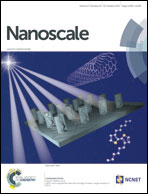Disentangling the effects of nanoscale structural variations on the light emission wavelength of single nano-emitters: InGaN/GaN multiquantum well nano-LEDs for a case study†
Abstract
The scattering in the light emission wavelength of semiconductor nano-emitters assigned to nanoscale variations in strain, thickness, and composition is critical in current and novel nanotechnologies from highly efficient light sources to photovoltaics. Here, we present a correlated experimental and theoretical study of single nanorod light emitting diodes (nano-LEDs) based on InGaN/GaN multiquantum wells to separate the contributions of these intrinsic fluctuations. Cathodoluminescence measurements show that nano-LEDs with identical strain states probed by non-resonant micro-Raman spectroscopy can radiate light at different wavelengths. The deviations in the measured optical transitions agree very well with band profile calculations for quantum well thicknesses of 2.07–2.72 nm and In fractions of 17.5–19.5% tightly enclosing the growth values. The nanorod surface roughness controls the appearance of surface optical phonon modes with direct implications on the design of phonon assisted nano-LED devices. This work establishes a new, simple, and powerful methodology for fundamental understanding as well as quantitative analysis of the strain – light emission relationship and surface-related phenomena in the emerging field of nano-emitters.


 Please wait while we load your content...
Please wait while we load your content...